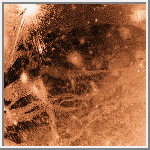|
COMETS EARTH JUPITER KUIPER BELT MARS MERCURY METEORITES NEPTUNE OORT CLOUD PLUTO SATURN SOLAR SYSTEM SPACE SUN URANUS VENUS ORDER PRINTS
PHOTO CATEGORIES SCIENCEVIEWS AMERICAN INDIAN AMPHIBIANS BIRDS BUGS FINE ART FOSSILS THE ISLANDS HISTORICAL PHOTOS MAMMALS OTHER PARKS PLANTS RELIGIOUS REPTILES SCIENCEVIEWS PRINTS
|
Related Document
Download Options
This image of Ganymede was taken by Voyager 1, 246,000 kilometers (158,000 miles) from the planet. The center of the picture is at 19° south latitude and 356° longitude, and the height of the frame represents a distance of about 1000 kilometers (600 miles) on the surface. The smallest features seen on this picture are about 2.5 kilometers (1.5 miles) across. The surface displays numerous impact craters many of which have extensive bright ray systems. The craters lacking ray systems are probably older than those showing rays. Bright bands traverse the surface in various directions and these bright bands contain an intricate system of alternating linear bright and dark lines which may represent deformation of the crusted ice layer. These lineations are particularly evident near the top of the picture. A bright band trending in a north-south direction in the lower left-hand portion of the picture is offset along a bright line. This offset is probably due to faulting. Two light circular areas in the right upper center of the picture may be the scars of ancient impact craters which have had their topographic expansion erased by flowage of the crystal icy material. This image is Copyright © by Calvin J. Hamilton. Any commercial/for-profit use of this image needs to be addressed to Calvin J. Hamilton. |
||||||||||||||||||||||||||
